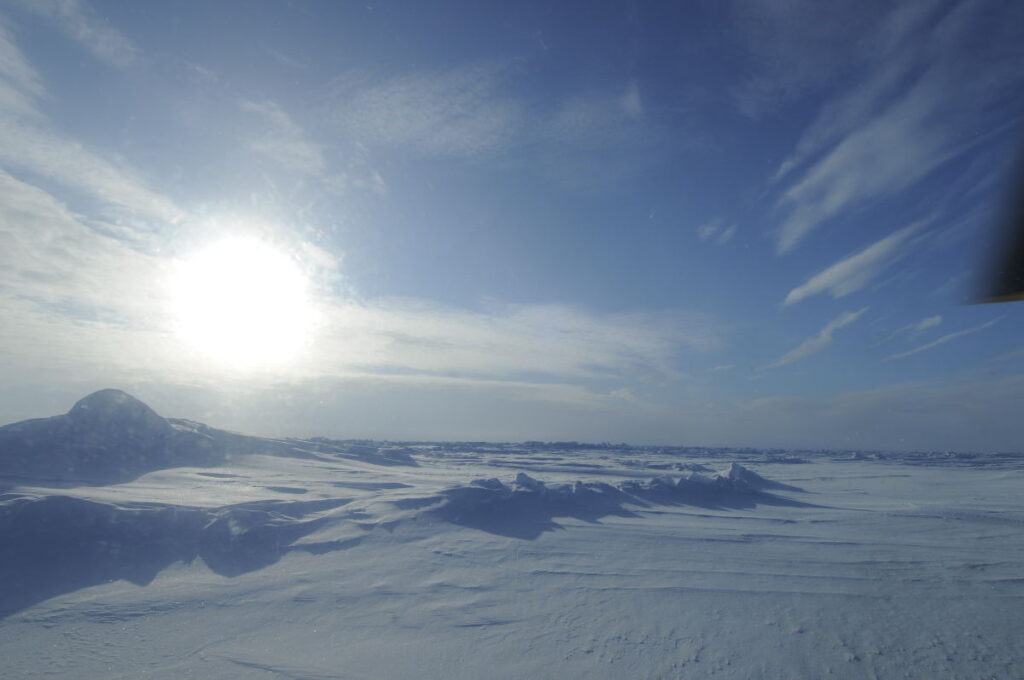The challenge

Ice is the pervasive reality of arctic environments. It is therefore critically important to understand ice characteristics and behaviour at the molecular level, as well as in interactions with natural features and man-made structures. Ice has one of the lowest values of fracture toughness on earth; fractures occur during all ice–structure interactions, whether involving the failure of an ice ridge keel as it gouges into seabed or local and global loading and induced vibration as ice impacts a vessel hull. Despite recent advances, fundamental questions remain regarding the influence of flaw structure, interaction geometry, temperature, time and the interplay between fracture and microstructural damage.
Ice Mechanics was a foundational topic for all CARD programs, since accurate modelling of the mechanics of ice–structure interactions are needed to develop appropriate design methods and effective station-keeping and ice management models.
Existing solutions
Despite the many challenges posed by pervasive presence of ice, industry has developed feasible solutions for production from fields in marginal sea ice and iceberg zones such as the Grand Banks, as well as capabilities to safely conduct exploratory drilling in areas such as the Beaufort Sea.
The Hibernia development, for example, relied upon a heavily toothed and steel-reinforced concrete gravity base structure to resist and dissipate the force of a posited iceberg impact.
The Terra Nova and WhiteRose developments relied upon ice-strengthened double-hulled FPSOs (to resist ice impact) with turrets that can be safely disconnected within hours from the wellhead umbilicals (to allow for rapid departure off station). Wellheads and production manifolds are set into excavated areas of seabed to avoid contact with ice keels.
Research topics
Key research topics for CARD’s Ice Mechanics Team include:
Mechanics of Ice Rubble (MIR) – Dr. Eleanor Bailey (Jan 2014 – December 2016)
Ice rubble is an accumulation of ice fragments formed when an intact ice sheet comes into contact with another ice sheet or an obstacle. Common features in the Arctic are sea ice ridges, which form when compression or shear in the ice cover causes piles of ice rubble to accumulate above and below the waterline. Arctic infrastructure must be designed to safely resist the loads imposed during potential interactions with these ice features. Greater understanding of the properties and behaviour of ice rubble improves confidence in load estimates associated with this hazard.
Built upon Dr. Bailey’s previous CARD project, Development of Ice Ridge Keel Strength (DIRKS), the main focus of the Mechanics of Ice Rubble (MIR) project was to gain a greater understanding of the fundamental mechanics and key physical parameters that contribute to the strength of an ice rubble feature as it interacts with a structure or the sea floor. CARD researchers conducted laboratory tests and numerical simulations to study the thermo-mechanical behavior of the ice rubble.
Development of Ice Ridge Keel Strength (DIRKS) – Dr. Eleanor Bailey (April 2011 – March 2015)
The Development of Ice Ridge Keel Strengths was a four-year collaborative venture between CARD and the National Research Council – Ocean, Coastal & River Engineering (NRC-OCRE). The main focus of the project was to investigate the failure mechanisms associated with gouging ice ridge keels and the conditions under which these keels will continue to gouge without failure. This is important for the design of subsea structures in shallow waters, where ice keels have been observed to scour the sea floor, posing a threat to pipelines and subsea infrastructure.
This project centered on a series of large-scale keel-gouge tests conducted in the NRC ice tank facility in St. John’s, NL, using the custom-built frame that was designed and used in the Pipeline Ice Risk Assessment and Mitigation (PIRAM) Joint Industry Project. Tests consisted of inserting a manufactured freshwater ice keel into the test frame and applying a constant vertical surcharge pressure whilst pushing a soil tray horizontally into the keel. The DIRKS project built upon the knowledge gained in the PIRAM tests and elucidated the effects that temperature, confining pressure and drift speed have on the strength and failure characteristics of a first-year ice keel.
Compressive Ice Failure and Distributed Damage (Perry Moore)
A constitutive model of ice for finite element analysis was coded in FORTRAN and used within the ABAQUS software. It was based on damage mechanics and takes into account microcracking, pressure softening, dynamic recrystallization and pressure melting. This damage-based model had in the past successfully recreated experimentally-observed ice behaviour. The model code was refined and modernized, producing better performance in modeling high-speed events, such as the formation of high-pressure zones (hpzs) believed to induce vibrations in structures.
Fracture and Scale Effect (Dr. Rocky Taylor)
Ice has one of the lowest values of fracture toughness on earth. Fractures occur during all ice–structure interactions and cause the scale effect whereby global pressures decrease with interaction area. Despite recent advances, fundamental questions remain regarding the influence of flaw structure, interaction geometry, temperature, time, and the interplay between fracture and microstructural damage. To help answer these questions, CARD developed programs of experimental and theoretical fracture research.
Data Analysis (Chris Rossiter with Dr. Martin Richard)
A model developed to analyze ship–ice interaction is currently being used to study a ship’s response when impacting a single ice feature. The program solves the surge and heave equations of motion, using a Runge-Kutta numerical integration scheme, and can take a variety of inputs ranging from floe parameters to ship characteristics. The load developed from the ship-ice interaction is modelled using a pressure-area curve where the pressure developing on the ship hull is related to the hull global contact area through an exponential relationship. The results of this work were an important input into the managed ice model (see next section).